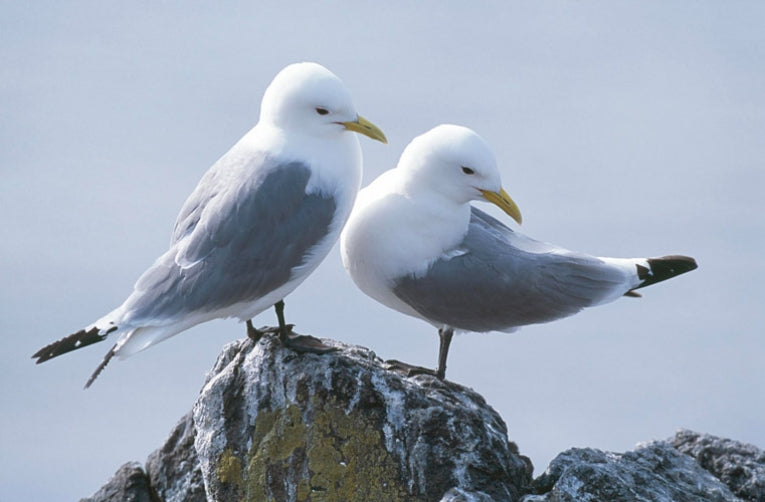(Image: Kittiwake pair standing on a rock.)
''Sat-nav'' to be used in new seabird programme to track birds around Europe's Atlantic coastline.
''We know more about the journeys of albatrosses in the Southern Ocean than we do about some of the seabirds around our own shores,'' said Dr Ellie Owen, a seabird scientist working on a European Union-funded project to track the movements of seabirds along the Atlantic coastlines of the UK, Ireland, France, Spain and Portugal.
The project, known as FAME - the Future of the Atlantic Marine Environment - is tracking the movements of seabirds to pinpoint areas that are important for these ocean travellers. This knowledge should assist the selection of marine protected areas which are vital for the survival of seabird species, some of which are declining rapidly.
![]()
(A bird known as a Shag being fitted with a GPS tracker as part of the F.A.M.E project. Photo by Andy Hay/RSPB)
Using technology similar to that found in car 'sat-nav' systems, the researchers tape tiny trackers to the backs of seabirds. These devices take a reading every 100 seconds, allowing the scientists to accurately pinpoint their subject's movements between the birds' nesting colonies and the areas of sea the birds use to find food. Accurate to within a few metres, the devices are providing the team with breathtakingly detailed information that they could have only dreamt about a few years ago.

(Dr Ellie Owen holding an adult male Shag, recently fitted with a GPS tracker as part of the F.A.M.E project. Ellie is wearing eye protection, as the bird might well go for her eyes, given the chance! Photo by Andy Hay/RSPB)
Ellie Owen said: ''The sights and sounds of thousands of seabirds packed into dense nesting colonies along our most rugged coastlines create some of our greatest wildlife spectacles: but, there are concerns that these colonies are dwindling as some species are struggling for survival.''
''Up to know we've known very little about the movements of these birds when they venture out to sea to find food. For example, we know how many kittiwakes there are in the UK, and we know they've declined by 30 per cent between 2000 and 2010. But we don't know where these ocean travellers are going to fish for their chicks' suppers. But now, just when these birds need our help, we're on the cusp of filling this information void with vitally-important data.''
From the south of Spain, along the Atlantic coast of Europe north to Fair Isle (between Orkney and Shetland), seabird scientists will be studying a variety of seabirds, ranging in size from the goose-sized gannet to sparrow-sized storm-petrels. Although seabirds nest on cliffs and islands, they all depend on the sea for their food and, ultimately, their survival

(Ellie Owen releases an adult male Shag with a tracker. After 3-4 days data is downloaded from the tracker onto a laptop computer, and the bird's movements to its feeding grounds can be analysed. Photo by Andy Hay/RSPB)
In the UK, scientists are working at five centres along the Atlantic coast: Fair Isle and Orkney in northern Scotland; Colonsay in the Hebrides; Bardsey Island in Wales; and the Isles of Scilly.
With its teeming seabird colonies, the Hebridean island of Colonsay is an important location for the scientists. Working in challenging conditions - battling the elements and the island's rugged terrain - Ellie and the team are adding to our understanding of seabirds.
She said: ''European seabirds face a variety of threats from dwindling food supplies, climate change, entanglement with fishing gear and pollution. By recording these birds' movements we are building a greater understanding of their requirements so we can begin to give these species the protection they need.''
In the UK, the FAME project will be working with the following seabird species: fulmar; shag; kittiwake; guillemot; and razorbill. Elsewhere scientists will be involved with other seabirds, including: gannet; European storm-petrel; Madeiran storm-petrel; and Balearic and Cory's shearwaters.
RSPB seabird scientist Mark Bolton said: ''We know that some species are declining rapidly. For example, the Balearic shearwater - a dove-sized relative of the albatross - is reckoned to be facing a greater threat of extinction than the tiger, mountain gorilla or giant panda.'' To counter this threat the RSPB are asking the public to sign a pledge to implement already-existing laws to protect seabirds.
You can sign the pledge here: www.rspb.org.uk/marine.
All the images courtesy of the RSPB.










